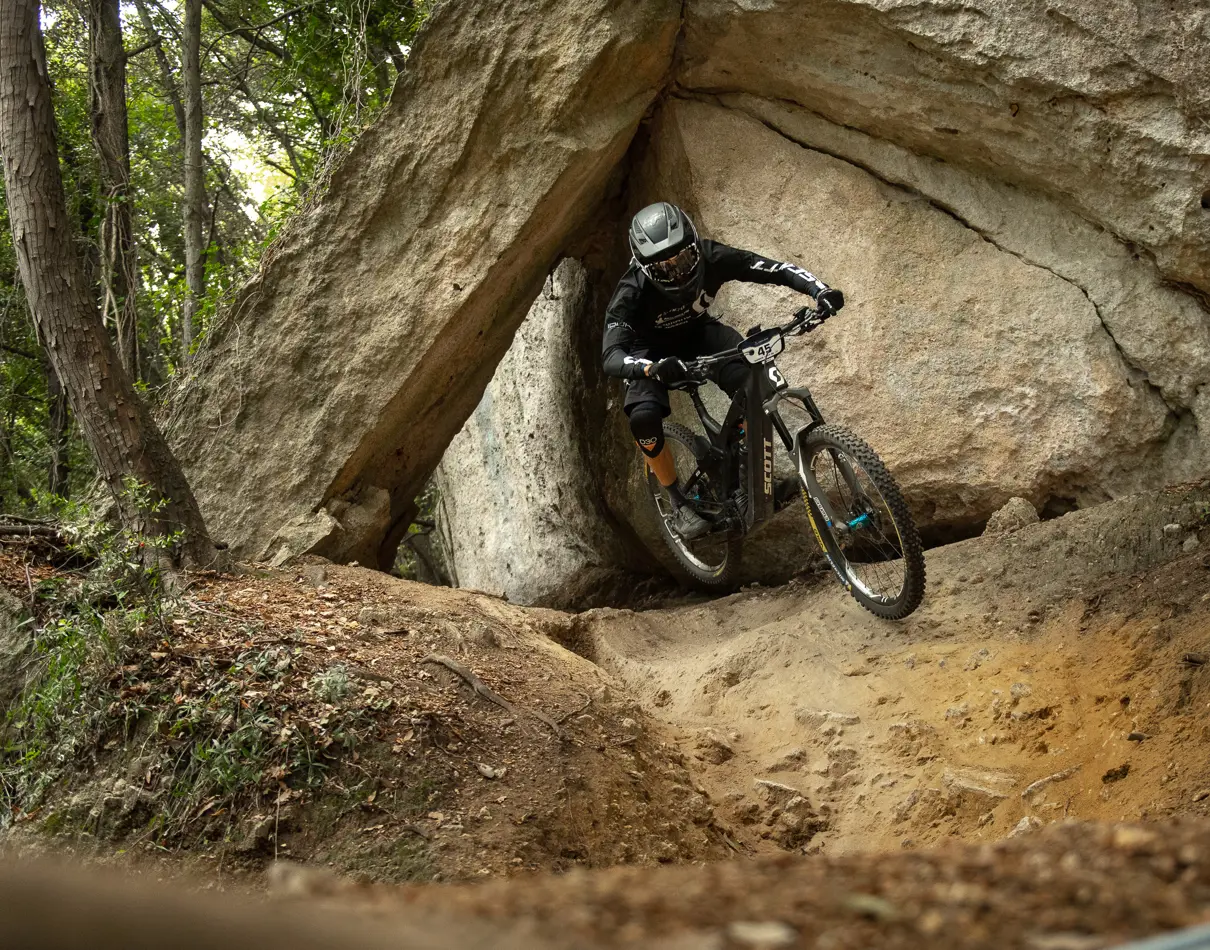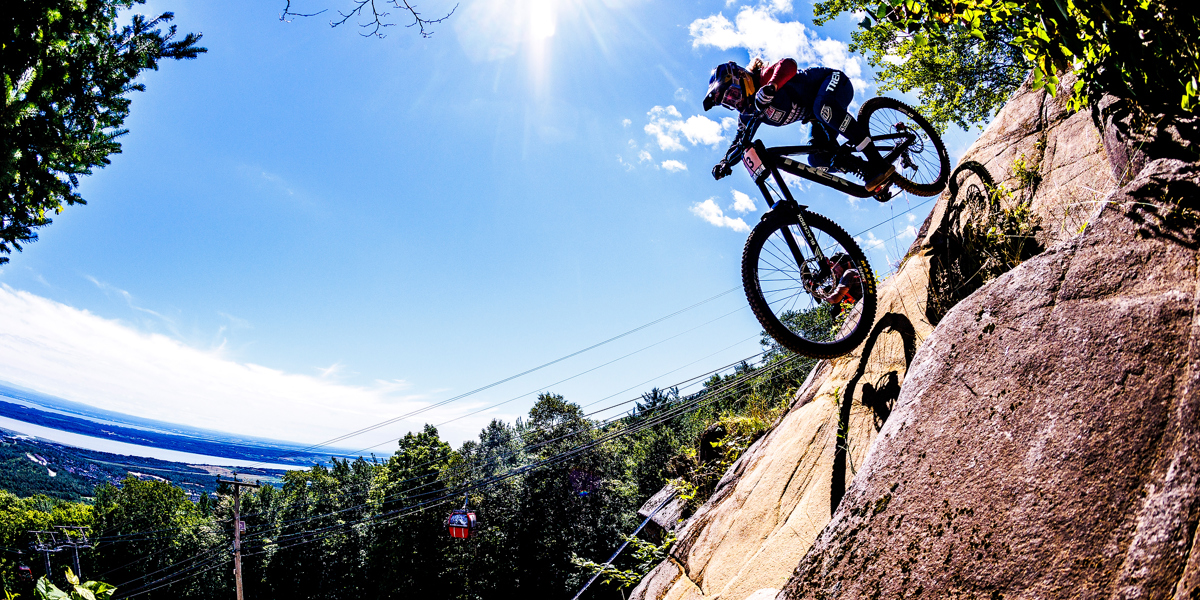What is Downhill Mountain Biking

Mountain biking is one of the most popular competitive and recreational sports in America.
Mountain biking is very diverse, which means there are many different sub-disciplines within the sport.
One of the most fast-paced disciplines is downhill, which is when mountain bikers start at the top of a mountain or hill and race to the bottom. In many cases, downhill trails are at mountain resorts, so racers don’t have to hike to the top and can use a cable car, or gondola lift, to travel instead.
Downhill mountain biking is one of the most thrilling categories of mountain biking for adrenaline seekers, as it involves high speeds on steep courses and ski slopes.
The difference between downhill and enduro mountain biking
Downhill mountain biking is a gravity sport, fueled with adrenaline. The courses are typically difficult, designed for daredevils who enjoy riding at speed. Due to its fast-paced nature, competitions are extremely close with the first-place rider winning by a fraction of a second in many cases.
On the other hand, as the name suggests, enduro mountain biking is a long-distance race over rough terrain to test a rider’s endurance. It incorporates elements from both downhill and cross country and its competitions typically feature three or more timed stages, held over a couple of days.
The trails
Downhill mountain biking trails are very steep, challenging and fast. Typically, each trail features lots of drops, rocks, gaps and technical corners for mountain bikers to test and improve their skill set.
Ski resorts are quite popular for downhill trails as they already have the facilities to transport riders to the top of the slope, such as cable cars. A trail with transport facilities means that mountain bikers don’t have to worry about how they’ll get to the start of the course.

There are numerous exciting downhill trails to try across the US. Whether you’re a beginner or a professional, there’s a trail for you to enjoy.
- Moab, Utah – one of the most popular bike parks in the US which has an approximate 1000 vertical feet drop to the road below.
- Sedona, Arizona – has a great pump park (a circuit of rollers and banked turns), tech flow trail (rocky and rooty terrain) and many more engaging features for riders.
- Bentonville, Arkansas – has layers of ancient limestone and 28 miles of award-winning bike trails.
- Grand Valley, Colorado (Fruita / Grand Junction / Palisade) – features the Palisade Plunge which is a singletrack trail of 32 miles, connecting the top of Grand Mesa to the Town of Palisade.
- Crested Butte, Colorado and the Gunnison Valley – have over 30 miles of lift-served singletrack, with trails perfect for beginners and gravity experts.
- Park City, Utah – features downhill and jump trails ranging from beginner level to advanced.
- Pisgah, North Carolina (Brevard / Asheville / Old Fort) – known for its challenging trails, pristine forests and miles of singletrack.
- Lake Tahoe, Nevada – the area is surrounded by alpine lakes, mountains and forests, with courses for all abilities.
- Copper Harbor, Michigan – ranked as one of the top 5 trail systems in the world, offering some of the most unique terrains, featuring a series of rocky, undulating ridges and valleys, as well as the most difficult trails in the US.
- Kingdom Trails, Vermont – over 85 miles of both single and doubletrack trails on private land.
You can also find bike courses outside of the designated parks, but these may be harder to gain access to unless they have a nearby road to reach the top. Alternatively, mountain bikers can also hike up the hill, as downhill mountain bikes are not designed for uphill pedaling.
Since downhill trails can be challenging, it’s a good idea to take a test ride before heading down at full speed, to get a feel for the trail.
What bikes can be used
Due to the nature of such extreme sports, you cannot use a regular commuter bike when doing downhill mountain biking. A typical commuter bike is not designed to withstand a downhill mountain bike course, so it would either fall apart during the ride or throw you off. To complete a downhill course, you will need a downhill bike which is specifically designed to handle rigorous riding.
Mountain bikes have a similar suspension to cars and motorcycles to handle rough terrain and have powerful brakes to control high speeds. Not only this, but they also have the perfect balance of stiffness and strength, whilst remaining light enough to give the rider the best performance.
What equipment is needed for downhill mountain biking?
Downhill mountain bikers need to wear the most protective gear, including:
- Mountain bike knee guards – as your knees are typically one of the first places on your body to hit the ground in a crash, it’s important that you keep them protected. With D3O-protected knee guards, you can push your limits with confidence.
- Mountain bike back protection – to safeguard this vulnerable area, you can use a back protector or baselayer with an integrated back protector. Some backpacks also come with back protectors built in, which is extremely convenient.
- Mountain bike chest protection – again here you can pick from chest protector and integrated baselayer options. Protective baselayers sometimes include pads for both the back and chest and can even extend to shoulders (for short-sleeved versions) and elbows (long-sleeved) for comprehensive protection.
- Mountain bike elbow guards – you need total freedom to move your elbows whilst riding as well as protection in case you crash. Choosing elbow guards with D3O pads provides the best combination of shock absorption and freedom of movement helping you keep control of your bike.
- Mountain bike gloves – these help mountain bikers keep a grip on the handlebars and brakes, and maintain control whilst going downhill.
- Mountain bike shoes – to keep your feet secure on the pedals, dedicated mountain bike shoes with a flat sole provide the best grip. By choosing D3O-protected mountain bike shoes, you’ll be equipped for the challenges of each ride, from variable weather to bumpy terrains.
- Clothing – wear what you feel most comfortable in and apparel that’s weather appropriate. Typically, on a dry and sunny day, mountain bikers opt to wear baggy kits.
- Eyewear – while you're riding down the trail, you should wear goggles or cycling glasses to protect your eyes from debris and mud.
How to ride downhill
To keep your balance when riding downhill, shift your hips slightly backwards to just behind the seat and keep your weight balanced between both wheels.
- Drop your heels. By bracing your feet against the pedals, your body will be able to maintain its stability and resist the forces that downhill braking puts on your body.
- Keep your arms and legs bent. As you descend on rough terrain, bend your elbows and knees to provide your joints with extra support.
- Shift your hips back slightly. A steep descent will affect your range of motion, so make sure to adjust your body position accordingly: further back the steeper the descent but without touching your tire.
- Chin over the stem. To build traction and stability, lower your chest and hips. Your chin should remain over the stem whilst you descend to keep your weight balanced.
- Ease the squeeze. Be careful not to lock your wheels, which could lead to you losing control of your bike. Maintain a strong stance on your bike and feather your front and rear brakes.
- Scan the trail. From time to time, scan the trail for places of traction and momentum blockers.